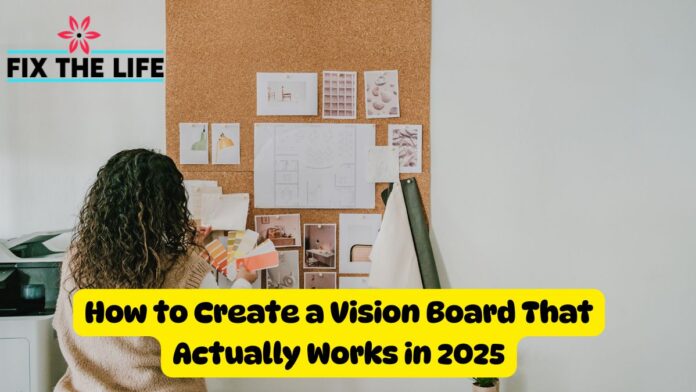Vision boards aren’t just trendy DIY projects — they’re a proven tool for clarifying your goals, boosting motivation, and focusing your mindset. If you’ve tried one before and it ended up gathering dust, it’s time to upgrade your strategy. In 2025, with refined manifestation techniques and smarter goal setting, you can create a vision board that genuinely supports your ambitions and keeps you aligned with what matters most.
Why Vision Boards Matter
At their core, vision boards are visual representations of your dreams, goals, and intentions. They serve as a daily reminder of where you’re headed, reinforcing positive focus and keeping your mind aligned with your desires.
Research in psychology and neuroscience shows that visualization strengthens motivation pathways in the brain, making you more likely to take action. When combined with intentional goal setting and strategic manifestation, your vision board becomes more than decoration — it’s a tool for change.
Key Steps to Create a Vision Board That Works
1. Get Clear on Your Goals
Before collecting images or quotes, take time to reflect on what you truly want. Consider different areas of your life:
- Career or business
- Health and wellness
- Finances
- Relationships
- Travel or adventure
- Personal growth
Use journaling, meditation, or brainstorming exercises to clarify your intentions. Be specific. Vague desires like “be happier” are harder to visualize and act upon than clear goals like “run a 5K by September” or “save $5,000 for a trip to Japan.”
2. Choose the Right Format
In 2025, there are more options than ever. You can:
- Create a traditional poster board vision board with magazine cutouts, printed photos, and handwritten notes.
- Design a digital vision board using apps like Canva, Pinterest, or Vision Board apps that let you update and access it from your phone.
- Combine both for versatility — a physical board for your workspace and a digital version for your lock screen or desktop wallpaper.
3. Gather Meaningful Visuals and Words
Focus on images, symbols, and words that emotionally resonate with you. These should spark excitement or calm determination when you see them.
Examples:
- A picture of a mountain trail for health goals.
- A photo of a passport or airplane for travel dreams.
- Quotes like “Progress, not perfection” for motivation.
- A screenshot of a job title or company you aspire to join.
Your board should tell a visual story of your future, not just look aesthetically pleasing.
4. Incorporate Manifestation Techniques
Pair your vision board with manifestation techniques to amplify its impact:
- Daily visualization: Spend a few minutes each morning visualizing yourself achieving the goals on your board.
- Affirmations: Write positive, present-tense affirmations next to your images.
- Gratitude practice: Stay thankful for what you have while focusing on what’s coming, reinforcing abundance and positive energy.
This intentional mental rehearsal primes your brain to notice opportunities and stay aligned with your goals.
5. Display It Where You’ll See It
Visibility is crucial. Place your vision board in a space you frequent — your bedroom wall, office desk, or phone lock screen. Regular exposure strengthens subconscious connections and keeps your intentions top of mind.
Goal Setting Tips to Complement Your Vision Board
Your vision board works best when paired with actionable goals. Follow SMART goal principles:
- Specific
- Measurable
- Achievable
- Relevant
- Time-bound
For example, instead of “get fit,” set a goal like “complete three 30-minute workouts per week for three months.”
Break bigger goals into smaller milestones and track your progress monthly. This turns inspiration into action.
Recommendation
Childcare and Nurseries: Providing Quality Early Education and Care
Why You Should Evaluate Online Education Opportunities Before Enrolling
Causes and Remedies for 9 Month Sleep Regression
Why Parenting Styles Matter When Raising Children?
Active Gym Games That Will Cheer Up Your Kids
Baby Nursery Rugs that Will Make a Hit out-and-out
Baby Stroller Fans That Comes in Handy
FAQ
Q1: Do vision boards really work, or is it just a trend?
A: Vision boards are backed by visualization psychology, which helps increase motivation and focus. Combined with clear goals and daily action, they’re a practical tool.
Q2: Is it better to make a physical or digital vision board?
A: Both work well. Choose a format you’ll consistently see and engage with. Many people combine physical boards for home and digital ones for their phone or computer.
Q3: How often should I update my vision board?
A: Review your board every 3-6 months. Refresh images and goals as your priorities evolve or when you accomplish milestones.
Q4: Can I manifest anything using a vision board?
A: While vision boards boost focus and confidence, they must be paired with actionable steps. Manifestation supports mindset, but effort drives results.
Q5: What should I avoid when making a vision board?
A: Avoid overcrowding, vague goals, and images that don’t truly resonate. The board should be meaningful, focused, and emotionally compelling to you.
Final Thoughts
Learning how to create a vision board that actually works in 2025 means going beyond cut-and-paste collages. It’s about combining visuals with focused goal setting, proven manifestation techniques, and daily action. When done intentionally, your vision board becomes a powerful tool for keeping your dreams visible, your mindset positive, and your progress consistent.




